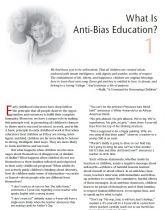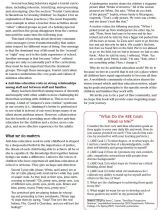Hledej
Zobraz:
Univerzity
Kategorie
Rozšířené vyhledávání
12 662
projektů
Anti-Bias Education for Young Children and Ourselves
| Přípona |
Typ studijní materiál |
Stažené 0 x |
| Velikost 0,9 MB |
Jazyk český |
ID projektu 9807 |
| Poslední úprava 06.03.2017 |
Zobrazeno 1 047 x |
Autor: kungs |
 Sdílej na Facebooku
Sdílej na Facebooku |
||
| Detaily projektu | ||
- Cena:
2 Kreditů - kvalita:
91,3% -
Stáhni
- Přidej na srovnání
- Univerzita:Univerzita Hradec Králové
- Fakulta:Pedagogická fakulta
- Kategorie:Humanitní vědy » Pedagogika
- Předmět:Multikulturní výchova a vzdělávání
- Studijní obor:-
- Ročník:3. ročník
- Formát:PDF dokument (.pdf)
- Rozsah A4:13 stran
What Is Anti-Bias Education?
Early childhood educators have deep faith in the principle that all people deserve the opportunities and resources to fulfi ll their complete humanity. Moreover, we have a unique role in making this principle real, in promoting all children’s chances to thrive and to succeed in school, in work, and in life. A basic principle in early childhood work is that when educators treat children as if they are strong, intelligent, and kind, children are far more likely to behave in strong, intelligent, kind ways. They are more likely to learn and thrive and succeed.
But what happens when children receive messages about themselves of disapproval, of disdain, of dislike? What happens when children do not see themselves or their families refl ected and respected in their early childhood programs? When adults do not actively guide children’s thinking about diversity, how do children make sense of information—accurate or biased—about people who are different from themselves?
Early childhood educators have deep faith in the principle that all people deserve the opportunities and resources to fulfi ll their complete humanity. Moreover, we have a unique role in making this principle real, in promoting all children’s chances to thrive and to succeed in school, in work, and in life. A basic principle in early childhood work is that when educators treat children as if they are strong, intelligent, and kind, children are far more likely to behave in strong, intelligent, kind ways. They are more likely to learn and thrive and succeed.
But what happens when children receive messages about themselves of disapproval, of disdain, of dislike? What happens when children do not see themselves or their families refl ected and respected in their early childhood programs? When adults do not actively guide children’s thinking about diversity, how do children make sense of information—accurate or biased—about people who are different from themselves?
Klíčová slova:
anti-bias
education
teacher
learning
gender identity
family structures
environment
Obsah:
- Foreword—A Renewed Sense of Hope vi
Carol Brunson Day
Prologue—A Few Words about This Book vii
Key Termsxi
Chapter 1. What Is Anti-Bias Education? 1
Chapter 2. Children’s Identity Development 11
Chapter 3. Becoming an Anti-Bias Teacher: A Developmental Journey 20
Chapter 4. Creating an Anti-Bias Learning Community 32
Positive interactions with children 32
Positive relationships with and among families 36
The visual and material environment 43
Curriculum planning, including persona dolls 47
Chapter 5. Learning about Culture, Language, & Fairness 55
Chapter 6. Learning about Racial Identity & Fairness 77
Chapter 7. Learning about Gender Identity & Fairness 90
Chapter 8. Learning about Economic Class & Fairness 101
Chapter 9. Learning about Family Structures & Fairness 112
Chapter 10. Learning about Different Abilities & Fairness 125
Chapter 11. Learning about Holidays & Fairness 135
Anti-Bias Education with Other Age Groups 149
Epilogue—Keeping On Keeping On: The Anti-Bias Journey Continues 157
Checklist for Assessing the Visual Material Environment 161
About the Contributing Writers 163
References 165

